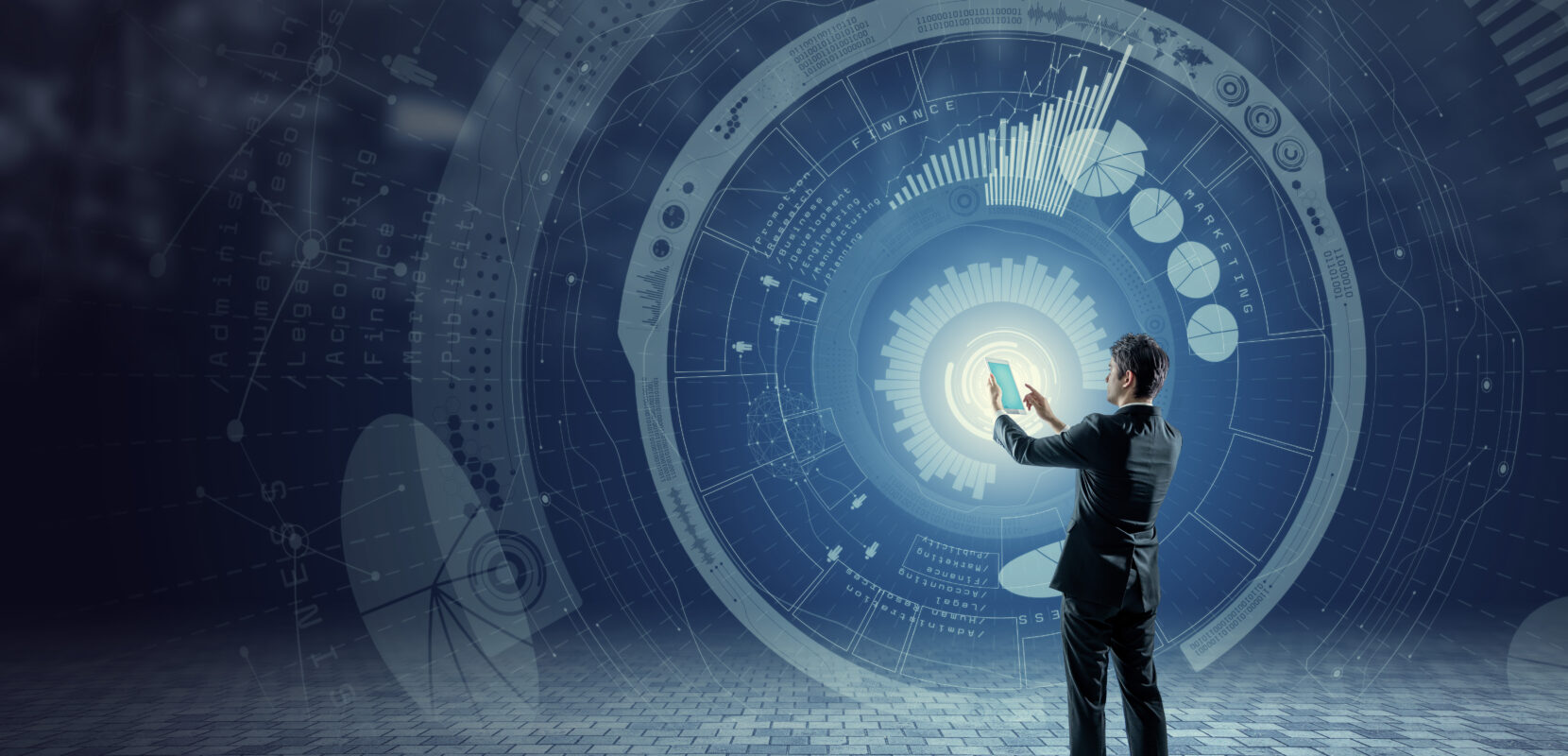It is hardly “breaking news” that technology is radically changing almost every aspect of our lives and the world around us – but we talk far less about the challenges that come along with this rapid evolution. And we certainly don’t know the answer to the important question: what is the ultimate outcome of this Digital Revolution?
To understand this issue, we should recognize exactly how fast things are really changing. A good metric for this purpose is the floating-point operation: a single mathematical calculation (like addition or multiplication) on two numbers that have decimal points.
In 1954, IBM introduced the first mass-produced computer with dedicated floating-point arithmetic hardware. The IBM 704 was regarded as the only computer that could handle complex math at that time: it could execute up to 12,000 floating-point operations per second, or FLOPS. It also weighed 15 tons and cost approximately $20,000,000 inflation adjusted U.S. dollars.
In 1984, thirty years later, a supercomputer called the Cray X-MP/48 was released, boasting a peak system performance of over 800 million FLOPS. It cost $36,000,000, adjusted for inflation.
Today, 36 years later, a single iPhone 11 claims up to one TRILLION FLOPS, about 1,250 times faster than the Cray supercomputer. Yet it costs 20 thousand times less and takes up a tiny fraction of the space. High end graphics chips (GPUs), for just a few thousand dollars each, can perform over 10 trillion floating point operations per second.
To try to comprehend this, that is approximately one billion times faster than the first IBM 704. If it had started running a computation on the day it was released, which just finished today, 66 years later, it would take a single modern GPU under TWO SECONDS to complete that same calculation.
And with little more than a credit card, anyone can spin up hundreds or even thousands of times this power in the Cloud, providing easy access to quadrillions of FLOPS. For the record, quadrillion means “one thousand million million” (in case you forgot). This is a trillion-fold increase in computing power from that 30,000-pound calculator.
If you didn’t care much for math in school, you may be wondering why anyone should give a damn about how fast we can multiply numbers together. Well, it turns out that all these FLOPS form the basis for what may turn out to the most disruptive technology of all time: they power the neural networks that are responsible for rapid advances in machine learning and artificial intelligence.
Ok, so maybe all those big numbers are important after all. And yet – what has this unprecedented explosion of raw power gotten us? To be sure, we now have many conveniences that might have seemed like magic a few decades ago, such as the amazing capability that a smart phone delivers to the palm of our hand. And things like autonomous vehicles, while not quite widespread, are steadily marching forward – relatively few people would have predicted it 10 years ago.
But if you have been paying attention to world recently, you might also have seen some less magical things. For example, the contents of our private lives are being spilled out into the open, for profit and political gain. Major technology platforms have been corrupted to sow disinformation and division in service of geopolitical conflict. Digital media is driving increasing polarization of ideology and isolation of thought. And of course, increasing dependence and addiction to technology is driving actual physical and social isolation.
And perhaps even scarier, over the last few years we have seen cyber-criminals holding countless enterprises and even local governments hostage with ransomware attacks. We’ve found evidence of nation-state actors conducting cyber-attacks against U.S. critical infrastructure, including nuclear power plants. And generally, we have witnessed an ongoing escalation of criminal and nation-state cyber activity across the board, leaving us in a perpetual state of “cyber arms race”.
I have always been fascinated by the power of technology to solve problems, but recent events continue to highlight that as the entire world is becoming increasingly dependent on rapidly evolving technology, most of our most critical institutions are not keeping up. And it’s not clear they can fix it.
To make matters worse, everything is accelerating – not just raw computing power, but advances in platforms and techniques that build upon one another to make the next advance even faster. An ever increasingly connected ecosystem that allows knowledge and capabilities to be shared effectively, driving even more rapid innovation.
Acceleration is defined as an increase in the rate of change. When the rate of acceleration changes, that is called “jerk” (like when you are driving a sports car and hit the gas from zero). I personally believe we are currently experiencing a technological “jerk”, in which the rate of acceleration is increasing sharply.
Consequently, instead of taking 60 years for another trillion-fold increase in computing power, maybe it only takes 25. With things like Quantum computing on the horizon, this is not remotely far-fetched. What happens then? For starters, we need to start looking up the names of really large numbers that nobody ever uses, like octillion and nonillion.
But famous futurist and fellow MIT alum Ray Kurzweil has applied some serious thinking to this matter. He predicted that in less than 25 years (2045 to be exact), $1,000 will buy a computer a billion times more intelligent than every human combined. He claims this will lead to something called the “technological singularity”, as artificial intelligence surpass human beings as the smartest life forms on the Earth. Technological development is taken over by machines, who can think, act and communicate so quickly that normal humans cannot comprehend what is going on.
These machines enter a “runaway reaction” of self-improvement cycles, with each new generation of A.I.s appearing faster and faster. From this point onward, technological advancement is explosive, under the control of the machines, and thus cannot be accurately predicted (hence the term “Singularity”). According to Kurzweil, the Singularity is an extremely disruptive, world-altering event that forever changes the course of human history. But he has a rosy view on potential “Terminator” like outcome – he thinks the extermination of humanity by violent machines is unlikely because sharp distinctions between man and machine will no longer exist. This will be thanks to the existence of cybernetically enhanced humans, as well as humans “uploaded” into machines.
Some others don’t have such an optimistic outlook. Elon Musk’s comments on the dangers of A.I. alarmed many when he spoke at MIT in 2014—speculating that it was humanity’s biggest existential threat. “With artificial intelligence, we are summoning the demon. You know all those stories where there’s the guy with the pentagram and the holy water and he’s like, yeah, he’s sure he can control the demon? Doesn’t work out.” Musk thinks things like autonomous weapon systems have the potential in the relatively near term to rapidly escalate kinetic conflicts and possibly lead to global world war.
So, are we headed for a Digital Apocalypse that destroys the world? Or is there a Digital Utopia in our future somewhere instead? We have been talking primarily about computers and information technology, but its worth mentioning that advances in many other areas have been impressive. Of course, in many cases these advances are enabled by IT in one way or another.
Gains in chemistry, biology, and materials science – things like nanotechnology, 3D printing, robotics, & medicine – have to potential to radically improve human heath, well-being, and quality of life. It is likely that the technology “jerk” will drive rapid advancement in these areas, possibly leading to reduction or elimination of hunger and poverty, and large increases in longevity.
But for a moment, think through the consequences of these kinds of changes. If our institutions are having a tough time keeping up now, how will they adapt to even greater and more disruptive changes? How will our businesses, governments, laws, and societal norms account for unintended consequences of amazing and seemingly positive changes in our world? How will they deal with intelligent machines?
What has become clear in all this uncertainty is that there is a disconnect between the rate of change of technology, and the rate of change in our most important institutions. There is also a lack of necessary technical expertise and human capital across many different parts of these institutions. Simply put, this is not good, and it is likely getting worse.
This presents a central paradox of this explosion in technology innovation: The faster we innovate and create ever more amazing possibilities for businesses, governments, and the whole human race, the harder it is for critical organizations to digest these changes. This creates an increased risk of major structural failures in these organizations, and society at large.
This presents an obvious and critical question: what exactly can we do about it? I believe it starts with leaders and policy makers who understand the broader changes, threats, and opportunities associated with the rapid advancement of technology across the globe. We need leaders both in government and commercial industry that understand how to build organizations which can survive and thrive through disruptive change.
Many such leaders are the driving force behind Digital Transformation initiatives across the world. This is a term that often gets diluted and co-opted for marketing purposes, but it is actually a critical imperative. What does it really mean?
Digital Transformation is fundamentally about using technology, data, and design to radically improve business and mission outcomes. It means leveraging modern practices to develop true organizational agility. It requires rethinking customer/user experience and how organizations engage with these groups. It demands that organizations empower employees and enhance their collaboration and productivity. It drives the optimization of processes through re-engineering and aggressive automation. And it means creating products and business models with new digital capabilities that never before existed.
In the end, I believe it is only through the successful transformation of our critical organizations and industries that we can make the necessary ongoing adjustments to laws, policy, and behaviors to ensure a safe, productive, and prosperous future in the Digital Age!




